Title: Souvenir Album of the visit of Her Majesty Queen Victoria to the American Exhibition
Date: 1887
More metadata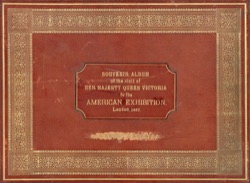
SOUVENIR ALBUM
of the visit of
HER MAJESTY QUEEN VICTORIA
to the
AMERICAN EXHIBITION.
London, 1887.
COL. HENRY S. RUSSELL.
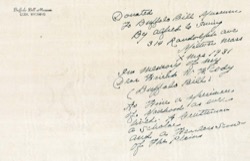
Buffalo Bill Museum
CODY, WYOMING
Donated to Buffalo Bill Museum By Alfred C. Irving 314 Randolph ave Milton Mass
X mas 1931
In memory of my Dear friend W F. Cody (Buffalo Bill)
As fine a specimen of manhood as ever lived. A Gentleman a Scholar and a Fearless Scout of The Plains
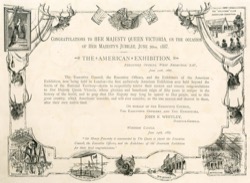
[border]border, four sides, with figures
QUEEN VICTORIA 1837.
E PLURIBUS UNUM
THE "WELCOME" CLUB AMERICAN EXHIBITION.
"WHEELOCK" ENGINE
NEW YORK HARBOUR
MAIN ENTRANCE
MAIN BUILDING
CONGRATULATIONS TO HER MAJESTY QUEEN VICTORIA, ON THE OCCASION
OF HER MAJESTY'S JUBILEE, JUNE 20TH, 1887.
THE AMERICAN EXHIBITION.
EXECUTIVE OFFICES, WEST BROMPTON, S.W.,
June 20th, 1887.
The Executive Council, the Executive Officers, and the Exhibitors of the American Exhibition, now being held in London—the first exclusively American Exhibition ever held beyond the limits of the National Territory—desire to respectfully tender their earnest and sincere congratulations to Her Majesty Queen Victoria, whose glorious and beneficent reign of fifty years is unique in the history of the world, and to pray that Her Majesty may long be spared to Her people, and to this great country, which Americans consider, and will ever consider, as the one nearest and dearest to them, after their own native land.
ON BEHALF OF THE EXECUTIVE COUNCIL,
THE EXECUTIVE OFFICERS AND THE EXHIBITORS,
JOHN R. WHITLEY,
Director-General.
WINDSOR CASTLE,
June 24th, 1887.
"Sir Henry Ponsonby is commanded by The Queen to thank the Executive Council, the Executive Officers, and the Exhibitors of the American Exhibition for their kind congratulations."

[border]border, four sides, with figures
QUEEN VICTORIA 1837.
E PLURIBUS UNUM
THE "WELCOME" CLUB AMERICAN EXHIBITION.
"WHEELOCK" ENGINE
NEW YORK HARBOUR
MAIN ENTRANCE
MAIN BUILDING
1887
WATERLOW & SONS LIMITED, LONDON WALL, LONDON.
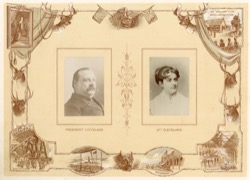
[border]border, four sides, with figures
QUEEN VICTORIA 1837.
E PLURIBUS UNUM
THE "WELCOME" CLUB AMERICAN EXHIBITION.
"WHEELOCK" ENGINE
NEW YORK HARBOUR
MAIN ENTRANCE
MAIN BUILDING
PRESIDENT CLEVELAND.
[photo]MRS. CLEVELAND.
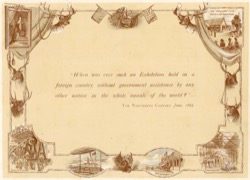
[border]border, four sides, with figures
QUEEN VICTORIA 1837.
E PLURIBUS UNUM
THE "WELCOME" CLUB AMERICAN EXHIBITION.
"WHEELOCK" ENGINE
NEW YORK HARBOUR
MAIN ENTRANCE
MAIN BUILDING
THE NINETEENTH CENTURY, June, 1887."When was ever such an Exhibition held in a foreign country without government assistance by any other nation in the whole annals of the world?"—
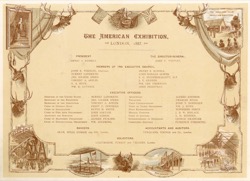
[border]border, four sides, with figures
QUEEN VICTORIA 1837.
E PLURIBUS UNUM
THE "WELCOME" CLUB AMERICAN EXHIBITION.
"WHEELOCK" ENGINE
NEW YORK HARBOUR
MAIN ENTRANCE
MAIN BUILDING
THE AMERICAN EXHIBITION,
-LONDON, 1887.-
- HENRY S. RUSSELL.
PRESIDENT.
- JOHN R. WHITLEY.
THE DIRECTOR-GENERAL.
- JOHN R. WHITLEY, Chairman.
- BURNET LANDRETH.
- JNO. GILMER SPEED.
- VINCENT A. APPLIN.
- E. A. BUCK.
- WM. D. GUTHRIE.
- HENRY S. RUSSELL.
- LORD RONALD GOWER.
- F. C. HUGHES-HALLETT, M.P.
- J. T. GRIFFIN.
- WM. LEE THORNTON.
- JOHN PRIESTMAN.
MEMBERS OF THE EXECUTIVE COUNCIL.
| DIRECTOR IN THE UNITED STATES | BURNET LANDRETH. |
| SECRETARY OF THE EXHIBITION | JNO. GILMER SPEED. |
| SECRETARY OF THE ASSOCIATION | VINCENT A. APPLIN. |
| CHIEF OF GENERAL STAFF | FREDc. C. PENFIELD. |
| CHIEF OF INSTALLATION | RUFUS M. SMITH. |
| CHIEF OF FINE ARTS DEPARTMENT | JOHN SARTAIN. |
| ARCHITECT AND SURVEYOR | JOHN GIBSON. |
| CHIEF OF MACHINERY DEPARTMENT | ALFRED PICKARD. |
| CHIEF OF HORTICULTURAL DEPARTMENT | WM. GOLDRING. |
| ACCOUNTANT | ALFRED JOHNSON. |
| TREASURER | CHARLES MILLS. |
| CHIEF CORRESPONDENT | JOHN T. DONNOLLY. |
| CHIEF OF TICKET DEPARTMENT | WM. J. ROWE. |
| PRESS REPRESENTATIVE | TOWNSEND PERCY. |
| MEDICAL DIRECTOR | J. B. W. BIDLACK. |
| CHIEF OF JANITORS | L. H. SKINNER. |
| SUPERINTENDENT OF ENTRANCES | GEORGE GRAINGER. |
| CONSULTING ENGINEER | FLORENCE O'DRISCOLL. |
- GLYN, MILLS, CURRIE AND CO., London.
BANKERS.
- TURQUAND, YOUNGS AND CO., London.
ACCOUNTANTS AND AUDITORS.
- ULLITHORNE, CURREY AND VILLIERS, London.
SOLICITORS.
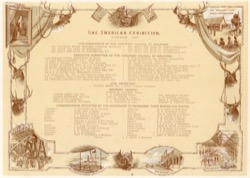
[border]border, four sides, with figures
QUEEN VICTORIA 1837.
E PLURIBUS UNUM
THE "WELCOME" CLUB AMERICAN EXHIBITION.
"WHEELOCK" ENGINE
NEW YORK HARBOUR
MAIN ENTRANCE
MAIN BUILDING
THE AMERICAN EXHIBITION,
LONDON, 1887.
- HIS EMINENCE HENRY EDWARD, CARDINAL MANNING.
- HIS GRACE THE DUKE OF ROXBURGHE.
- HIS GRACE THE DUKE OF MANCHESTER, K.P.
- HIS GRACE THE DUKE OF NORTHUMBERLAND.
- HIS GRACE THE DUKE OF WELLINGTON.
- HIS GRACE THE DUKE OF SUTHERLAND, K.G.
VICE-PRESIDENTS OF THE HONORARY COUNCIL OF WELCOME.
- LORD RONALD GOWER, Stafford House, St. James's.
- SIR JOHN HERON-MAXWELL, BART., Carlton Club.
- SIR JOHN E. MILLAIS, BART., 2, Palace Gate, Kensington.
- SIR SIDNEY WATERLOW, BART., 26, Great Winchester Street, E.C.
- SIR DAVID SALOMONS, BART., 41, Lowndes Square, S.W.
- COL. F. C. HUGHES-HALLETT, M.P., 108, Cromwell Road, S.W.
- SIR H. P. DE BATHE, BART., Hollandsfield, Chichester.
- J. H. PULESTON, ESQ., M.P., 2, Bank Buildings, Princes Street, E.C.
- SIR J. J. COGHILL, BART., 8, Penywern Road, South Kensington.
- SIR CHARLES CLIFFORD, BART., Hattherton Hall, Cannock, Staff.
- E. NORTH BUXTON, ESQ, Knighton, Buckhurst Hill.
- HENRY IRVING, ESQ, Lyceum Theatre.
- COL. PAGET MOSLEY, Carlton Club.
- DR. MORELL MACKENZIE, 19, Harley Street, Cavendish Square, W.
- GILEAD SMITH, ESQ., St. George's Club, Hanover Square.
- MAJOR S. FLOOD PAGE, Albert Mansions, Victoria Street.
- SIR JOSEPH FAYRER, 53, Wimpole Street, W.
- WILKIE COLLINS, ESQ., 90, Gloucester Place, Portman Square.
- CHARLES WYNDHAM, ESQ., Criterion Theatre, Piccadilly.
- HENRY SETON-KARR, ESQ., M.P., Queen's Gate.
EXECUTIVE COMMITTEE OF THE HONORARY COUNCIL OF WELCOME.
- J. STEPHEN JEANS, ESQ., 2, Victoria Mansions, Westminster.
HON. SECRETARY.
- GEORGE M. PULLMAN, Chicago.
- NORVIN GREENE, New York.
- ALBERT BIERSTADT, New York.
- JOHN LUCAS, Philadelphia.
- THOMAS COCHRAN, Philadelphia.
- N. K. FAIRBANK, Chicago.
- JOHN B. CARSON, Chicago.
- W. J. COLEMAN, San Francisco.
- W. H. THOMSON, St. Louis.
- WM. EDWARDS, Cleveland.
- L. M. DAYTON, Cincinnati.
- JOHN E. GREENE, Louisville.
- ROBERT W. FURNAS, Nebraska.
ADVISORY COUNCIL.
| CALIFORNIA | A. ANDREWS, of San Francisco. |
| COLORADO | NOEL MAY, of Denver. |
| GEORGIA | THOMAS P. STOVALL, of Atlanta. |
| IDAHO | P. J. KINNEY, of Boise City. |
| KANSAS | FREDERICK COLLINS. |
| LOUISIANA | SAMUEL P. BLANC, of New Orleans. |
| " | JAMES T. GRIFFIN, of London, England. |
| MAINE | J. B. HAM, of Lewiston. |
| MARYLAND | J. THOMAS SCARF, of Baltimore. |
| MICHIGAN | F. W. NOBLE, of Detroit. |
| MINNESOTA | W. D. WASHBURN. |
| MONTANA | JOHN E. KENNEDY, of Blatchford. |
| NEBRASKA | W. F. CODY, of North Platte. |
| NEVADA | W. M. HAVENER, of Reno. |
| NEW JERSEY | WM. S. TAYLOR, of Burlington. |
| NEW MEXICO | W. B. SLOAN, of Santa Fé. |
| NORTH CAROLINA | P. M. WILSON, of Raleigh. |
| OREGON | E. W. ALLEN, of Portland. |
| PENNSYLVANIA | J. G. DITMAN, of Philadelphia. |
| RHODE ISLAND | MARK H. WOOD, of Barrington Centre. |
| SOUTH CAROLINA | A. P. BUTLER, of Columbia. |
| TENNESSEE | L. B. McWHIRTER, of Nashville. |
| TEXAS | S. J. T. JOHNSON, of Corsicana. |
| VERMONT | JOHN B. MEAD, of Randolph. |
| VIRGINIA | E. B. MOON, of Richmond. |
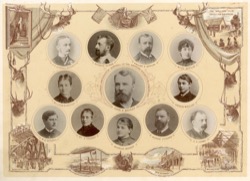
[border]border, four sides, with figures
QUEEN VICTORIA 1837.
E PLURIBUS UNUM
THE "WELCOME" CLUB AMERICAN EXHIBITION.
"WHEELOCK" ENGINE
NEW YORK HARBOUR
MAIN ENTRANCE
MAIN BUILDING
F. C. HUGHES-HALLETT
[photo]RONALD GOWER
[photo]VINCENT A. APPLIN
[photo]MISS APPLIN
[photo]MRS. JOHN R. WHITLEY
[photo]FOUNDER AND DIRECTOR-GENERAL OF THE AMERICAN EXHIBITION. LONDON, 1887.
JOHN R. WHITLEY
ARTHUR WHITLEY
[photo]W. D. GUTHRIE
[photo]MRS. A. PICKARD
[photo]BLANCHE WHITLEY
[photo]ALFRED PICKARD
[photo]J. S. JEANS
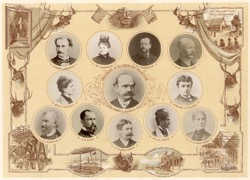
[border]border, four sides, with figures
QUEEN VICTORIA 1837.
E PLURIBUS UNUM
THE "WELCOME" CLUB AMERICAN EXHIBITION.
"WHEELOCK" ENGINE
NEW YORK HARBOUR
MAIN ENTRANCE
MAIN BUILDING
BURNET LANDRETH
[photo]MRS. LANDRETH
[photo]W. L. THORNTON
[photo]JOHN PRIESTMAN
[photo]MRS. H. S. RUSSELL
[photo]PRESIDENT OF THE AMERICAN EXHIBITION.
HENRY S. RUSSELL
HOWLAND S. RUSSELL
[photo]J. T. GRIFFIN
[photo]E. A. BUCK
[photo]JNO. GILMER SPEED
[photo]MRS. J. G. SPEED
[photo]MRS. J. PRIESTMAN
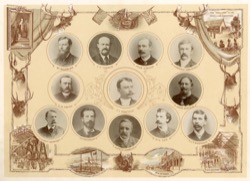
[border]border, four sides, with figures
QUEEN VICTORIA 1837.
E PLURIBUS UNUM
THE "WELCOME" CLUB AMERICAN EXHIBITION.
"WHEELOCK" ENGINE
NEW YORK HARBOUR
MAIN ENTRANCE
MAIN BUILDING
WM. GOLDRING
[photo]J. F. TANNER
[photo]JOHN GIBSON
[photo]FLORENCE O'DRISCOLL
[photo]R. M. SMITH
[photo]F. C. PENFIELD
[photo]JOHN SARTAIN
[photo]ALBERT BIERSTADT
[photo]A. BARTHOLDI
[photo]ALFRED JOHNSON
[photo]M. L. LEE
[photo]J. T. DONNOLLY

[border]border, four sides, with figures
QUEEN VICTORIA 1837.
E PLURIBUS UNUM
THE "WELCOME" CLUB AMERICAN EXHIBITION.
"WHEELOCK" ENGINE
NEW YORK HARBOUR
MAIN ENTRANCE
MAIN BUILDING
BIRD'S-EYE VIEW OF
THE AMERICAN EXHIBITION,
LONDON, 1887.
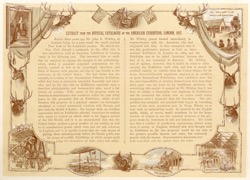
[border]border, four sides, with figures
QUEEN VICTORIA 1837.
E PLURIBUS UNUM
THE "WELCOME" CLUB AMERICAN EXHIBITION.
"WHEELOCK" ENGINE
NEW YORK HARBOUR
MAIN ENTRANCE
MAIN BUILDING
EXTRACT FROM THE OFFICIAL CATALOGUE OF THE AMERICAN EXHIBITION, LONDON, 1887.
ABOUT three years ago Mr. John R. Whitley, of London, being on a tour round the world, reached New York on his homeward journey. He read in the New York Herald a paragraph to the effect that it was intended to hold an American Exhibition in London early in the following year. This interested him so much that he resolved to engage his energies in the undertaking, which, whilst it promised congenial employment for his activity, seemed to him to be exceedingly attractive, and likely to become most popular, and also of vast benefit to the commerce of the United States. He had before him the example, in London, of the International Fisheries Exhibition, which had been so eminently successful, financially and otherwise, and he felt sure that an Exhibition, organised upon a first-class administrative and business-like plan, stood a fair chance of success. Fully aware of the progress made by America in manufactures and commerce within the past thirty years, he felt persuaded that an Exhibition, which should illustrate this progress in a practical manner was thoroughly calculated to extend commercial relations with Europe, and also with the British Colonies. He foresaw what an excellent opportunity such an Exhibition afforded Americans for making what might be termed an official débût in the biggest market of the Old World, and it is an unquestioned fact that the United States produce a great number of raw articles, as well as of manufactured goods, which were and are still unknown in England, and it is equally certain that the only means of placing them advantageously before the British public was by means of a public Exhibition, at which people could judge for themselves of their value and utility.
Mr. Whitley placed himself immediately in communication with the American who had originated this idea. It then transpired that it was this gentleman's purpose to hold an International Exhibition in London in 1885, and the Exhibition was to be called American, because the idea of it was conceived in America. Mr. Whitley was of opinion, however, that it would be wiser to defer opening the Exhibition until 1886, and that it should be confined entirely to exhibits from the United States; for he knew, from considerable experience acquired as an exhibitor at great International Exhibitions, how exhibitors have felt the utter impossibility of showing themselves at their best when their space was cut down to an insufficient minimum. In considering this matter, it seemed to Mr. Whitley that it was time to initiate a thoroughly new departure in Exhibitions, and he conceived the notion that no nation could better inaugurate such a departure than the American. His proposition was accepted, and practical work begun by consulting some of the most prominent men in Great Britain as to how such an undertaking would be received by the English public, which, of course, would contribute by far the larger number of visitors to see this practical evidence of the progress made by Americans in arts and industries. The result was that a number of gentlemen, representing almost every class of society in England, declared that they thought such an Exhibition as the one proposed would be not only of the greatest possible interest and value, but extremely popular with the masses. Representative Americans were next consulted, and the answer from the other
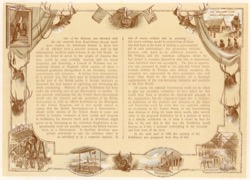 side of the Atlantic was identical with the one received from Englishmen, though much more modest, for Americans desired to know first of all, whether even a peaceful invasion, such as was contemplated, would be really welcome in the Old World. In order the better to prove to the people of America that they would be most cordially received with the truest hospitality and friendship, a Council of Welcome was immediately formed in England, which consists of about a thousand gentlemen distinguished in art, literature, science, manufactures, and commerce. It having been demonstrated, in a general way, that there were no insuperable objections on the part of the British public, it became necessary to determine the best manner of organising and developing the whole undertaking. Hitherto all great Exhibitions had been under the fostering care of one Government or another. It was naturally unbecoming that the United States Government should take the initiative and ask permission of the British Government to hold an official Exhibition in the Metropolis of the United Kingdom, and it was equally absurd to expect that the British Government—as a Government—should invite citizens of the United States to come and exhibit in London evidences of their wealth and progress in civilisation, for, however much such an Exhibition might prove to be interesting to the individual Englishman, it unquestionably could not possibly concern the British Government, as a Government. It therefore devolved upon private individuals to take the initiative, either in an individual or in a corporate capacity. It was of course evident that by adopting this course criticism would be invited from all those who had been in the habit of looking to governmental aid in such undertakings; this prospective criticism, however, only acted as an additional incentive to Mr. Whitley, and the American colleagues whom he had invited to associate themselves with him, to demonstrate what individual effort can accomplish. The plan of organisation was presented in detail to the principal United States Consuls resident in Europe, and, without exception, the enterprise was commended by these gentlemen, who well knew what would be the requirements for a thorough representation of the ever-increasing industries and resources of the New World.
side of the Atlantic was identical with the one received from Englishmen, though much more modest, for Americans desired to know first of all, whether even a peaceful invasion, such as was contemplated, would be really welcome in the Old World. In order the better to prove to the people of America that they would be most cordially received with the truest hospitality and friendship, a Council of Welcome was immediately formed in England, which consists of about a thousand gentlemen distinguished in art, literature, science, manufactures, and commerce. It having been demonstrated, in a general way, that there were no insuperable objections on the part of the British public, it became necessary to determine the best manner of organising and developing the whole undertaking. Hitherto all great Exhibitions had been under the fostering care of one Government or another. It was naturally unbecoming that the United States Government should take the initiative and ask permission of the British Government to hold an official Exhibition in the Metropolis of the United Kingdom, and it was equally absurd to expect that the British Government—as a Government—should invite citizens of the United States to come and exhibit in London evidences of their wealth and progress in civilisation, for, however much such an Exhibition might prove to be interesting to the individual Englishman, it unquestionably could not possibly concern the British Government, as a Government. It therefore devolved upon private individuals to take the initiative, either in an individual or in a corporate capacity. It was of course evident that by adopting this course criticism would be invited from all those who had been in the habit of looking to governmental aid in such undertakings; this prospective criticism, however, only acted as an additional incentive to Mr. Whitley, and the American colleagues whom he had invited to associate themselves with him, to demonstrate what individual effort can accomplish. The plan of organisation was presented in detail to the principal United States Consuls resident in Europe, and, without exception, the enterprise was commended by these gentlemen, who well knew what would be the requirements for a thorough representation of the ever-increasing industries and resources of the New World.
Of course, the national Government could not be asked to give any pecuniary assistance; to have asked for this would have been to abandon the fundamental principle of the organisation ; but the originators hoped that so complete an Exhibition of the products and resources of the States and Territories could be made that any capitalist seeking an investment in the United States, or any discriminating man desirous of fixing his home there, would, after several visits to the proposed Exhibition, be in a position to arrive at a reliable conclusion as to what it would be best for him to do, and that in this way the Exhibition would become, as it has, a national undertaking in the broadest and best sense of the term.
In the early part of 1886 the opening of the Exhibition was postponed from May of that
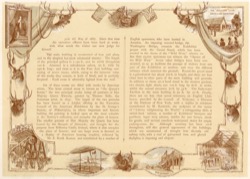 year till May of 1887. Since that time the executive officers have been hard at work; with what result the visitor can now judge for himself.
year till May of 1887. Since that time the executive officers have been hard at work; with what result the visitor can now judge for himself.
The main building is constructed of iron and glass, and in the simplest but most substantial manner. The length of the principle gallery is 1,140 ft., and its width throughout 120 ft. Annexed is a refreshment saloon, 90 ft. wide by 240 ft. long; and close to it is the Fine Arts building, consisting of seven rooms, which, owing to the immense value of the works they contain, is built of brick, and is perfectly fireproof. Each room is admirably lighted from the roof.
Six of these rooms are filled with works by American artists. The front central room is known as "the Queen's Room," the two principle works being oil portraits of Her Majesty Queen Victoria, painted by Thomas Sully, the American artist, in 1837. The larger of the two portraits has been loaned as a Jubilee offering to the Executive Council of the American Exhibition by the St. George's Society, of Philadelphia, in whose important and historic building the painting is looked upon as the most valuable in the Society's collection, and occupies the place of honour. The smaller portrait of Her Majesty the Queen has been loaned by the Marquis of Ormonde, and brought for the purpose from Kilkenny Castle, Ireland, where it also occupies the place of honour; and one large room is devoted to a display of American hunting trophies, collected by Mr. E. North Buxton and contributed by a number of English sportsmen, who have hunted in America. An imposing covered bridge, the Washington Bridge, connects the Exhibition proper with the Grand Stand, which has been erected in the Arena of the "Wild West," whence no less than 25,000 spectators can witness the "Sports of the Wild West." Seven other bridges have been constructed, so as to facilitate the passage of the visitors from one part of the Exhibition to another, and over the different railways which intersect the grounds. Round the grand stand is a refreshment bar about 700 ft. in length, and there are four other bars in other parts of the main building and grounds. In addition to these are a band stand in the western gardens, two electric light sheds, one 120 ft. long by 60 ft. in width, whilst the second measures 70 ft. by 35 ft. The Soda-water Pavilion in the main building is 20 ft. by 20 ft. Finally, there are no less than seven entrances, an English Clubhouse, provided by the Council of Welcome, a Diorama of the Harbour of New York, with a replica in miniature (contributed by M. Bartholdi, the sculptor) of the statue of "Liberty enlightening the World," a tobogganing slide, a switch-back railway, a number of Exhibitors' kiosques and pavilions, lager beer saloons, stables for 200 horses, sheds for goods, and several excellent waterproof stores for empty packing-cases, &c. Although economy has been used throughout, still the general appearance of the buildings, which are constructed of wrought iron tie-rods, old railway rails, with a roof of galvanised iron, and glazed skylights, is imposing and elegant.

[border]border, four sides, with figures
QUEEN VICTORIA 1837.
E PLURIBUS UNUM
THE "WELCOME" CLUB AMERICAN EXHIBITION.
"WHEELOCK" ENGINE
NEW YORK HARBOUR
MAIN ENTRANCE
MAIN BUILDING
THE GARDENS.
THE Gardens, occupying an area of about twelve acres, are approached from the north end of the building, from West Kensington Station, and from the North End Road entrance.
They are divided into two distinct portions, the intervening railway being spanned by two bridges, and from these a view of the whole grounds is obtained. The gardens have been designed and laid out by Mr. William Goldring, the landscape gardener, with the view of embracing as much variety as possible, and also to make the most effective display.
The Central Garden, or that immediately contiguous to the Exhibition building, is laid out in a rigidly formal style, which tends to heighten the effect of the north façade of the building, while the arrangement of broad and straight walks allows ample space for the free circulation of large masses of people.
The West Garden, on the other hand, is designed in a more natural style, the walks traversing the whole garden being graceful. Curving at one point, they wind through a picturesque grove of old trees, while others lead to the principal points of attraction. The old trees near the bandstand happily existed previous to the formation of the present garden, and the visitor may see how charmingly they harmonise with the surroundings.
The Diorama by A. Bartholdi and B. Lavastre presents a view of the Harbour of New York, and of the colossal monument of "Liberty enlightening the World." The view is taken from the deck cabin of a Hudson River steamer. The spectator sees the Statue of Liberty on Bedloe's Island, the Hudson River and the East River, the cities of New York, Brooklyn, and Jersey City, and the celebrated Brooklyn Bridge. The deck of the ship under the eyes of the spectators is filled with personages of which a great number are portraits, such as Mr. Laboulaye, President of the Committee of the Works; Count Sérurier, Vice-President; Mr. Evarts, President of the American Committee; M. Bartholdi, sculptor; M. Gaget, by whom the work was executed in bronze; M. Eiffel, and others. In the annexes of the diorama are shown an Ear of the statue, a model of the real size of the colossal statue, and a collection of photographs, showing the nature of the works and the different phases of the undertaking during the preparation and erection of the "Statue of Liberty."
In the gardens the visitor finds himself surrounded by the native trees, shrubs, and flowers of North America, for no others have been planted. They give an idea, however slight it may be, of the beauty and variety of North American vegetation. Many a tree, shrub, and flower will be recognised as familiar in English gardens, for it is a singular fact that for the last three centuries the
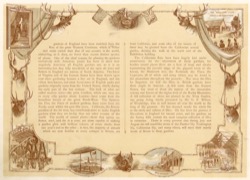 gardens of England have been enriched from the flora of the great Western Continent, which is richer and more varied than that of any country in the world, containing, as it does, no fewer than 10,000 distinct species of plants. One of the chief reasons for planting the gardens exclusively with American plants has been to show how singularly American all English gardens are, as it is an interesting fact that fully two-thirds of the open air trees and flowers in England are natives of North America. The forest of Virginia and of the Eastern States have been drawn upon ever since gardening became a fine art in England, and the oldest, best-known, and most loved trees of English parks and gardens originally came from the United States, chiefly during the early part of the last century. The bulk of what are called modern trees—the prim Conifers, which one may see in every villa garden about London—have come from the boundless forests of the great North-West. The Spruces, the Firs, the Pines of modern gardens, have come from the Pacific coast within the past fifty years. California, the flowery paradise of the far west, has contributed more to make English gardens what they are to-day than any other country of the world. The wealth of annual plants—those that spring up, flower, seed, and die in a year, are alone capable of making a garden glow with brilliant colours, of every shade, from one year's end to the other; in fact, the majority of annuals which are now familiar to every cottager in Britain, are from California, and some idea of the beauty of these may be gleaned from the California annual garden, skirting the walk at the north end of the Exhibition building.
gardens of England have been enriched from the flora of the great Western Continent, which is richer and more varied than that of any country in the world, containing, as it does, no fewer than 10,000 distinct species of plants. One of the chief reasons for planting the gardens exclusively with American plants has been to show how singularly American all English gardens are, as it is an interesting fact that fully two-thirds of the open air trees and flowers in England are natives of North America. The forest of Virginia and of the Eastern States have been drawn upon ever since gardening became a fine art in England, and the oldest, best-known, and most loved trees of English parks and gardens originally came from the United States, chiefly during the early part of the last century. The bulk of what are called modern trees—the prim Conifers, which one may see in every villa garden about London—have come from the boundless forests of the great North-West. The Spruces, the Firs, the Pines of modern gardens, have come from the Pacific coast within the past fifty years. California, the flowery paradise of the far west, has contributed more to make English gardens what they are to-day than any other country of the world. The wealth of annual plants—those that spring up, flower, seed, and die in a year, are alone capable of making a garden glow with brilliant colours, of every shade, from one year's end to the other; in fact, the majority of annuals which are now familiar to every cottager in Britain, are from California, and some idea of the beauty of these may be gleaned from the California annual garden, skirting the walk at the north end of the Exhibition building.
The Californian flora have been largely laid under contribution for the adornment of these gardens, for besides annual plants there are a host of trees and shrubs representing the juvenile stage of the gigantic trees of the forests, the Mammoth tree, the Redwood, the Pines, the Cypresses, all of which and many others may be found in the plantations throughout the grounds. Nor must the lilies be forgotten, for half the lilies in British gardens have their origin in America. A few come from the Eastern States, but most of them are natives of the mountains, cañons, and forests of the region west of the Rocky Mountains. A full collection of these are planted in the West Garden, one group being kindly presented by Mr. G. F. Wilson, of Weybridge, who is well known all over the world as the king of lily growers. He has devoted nearly his whole life to the study and culture of lilies. He has been the pioneer of lily-culture in England for twenty years, and his gardens on the Surrey hills contain the most complete collection of lilies in existence. There is every promise that during July and August the tall wand-like stems of the Panther lily, Washington lily, Californian lily, and many others, will wave their stately heads of bloom in these gardens.

[border]border, four sides, with figures
QUEEN VICTORIA 1837.
E PLURIBUS UNUM
THE "WELCOME" CLUB AMERICAN EXHIBITION.
"WHEELOCK" ENGINE
NEW YORK HARBOUR
MAIN ENTRANCE
MAIN BUILDING
The bulk of the plants in the garden are what are called hardy perennial plants that are at home in the English climate, and of these the collection is very rich. They have been contributed by Mr. Ware, of Tottenham, near London, who possesses the most extensive nursery of hardy plants in the world. The aim has been not to make a full collection of hardy American plants, as the temporary nature of the Exhibition Gardens forbade it, but a representative garden of native plants from the mountains, plains, prairies, swamps, and woods of North American, and Mr. Goldring has endeavored to create a perennial glow of colour throughout the whole period of the Exhibition, and he has also grouped the plants so as to produce either a pleasing harmony of colour or a decided contrast.
For instance, in one part is a large mass of yellow-flowered plants of the sunflower tribe, intermingled with the glowing scarlets of the Bee Balm (Monarda didyma), and the Cardinal flower (Lobelia cardinalis), of , the south-western States. In another part is a mass of the gorgeous Tiger flower of Mexico (Tigridia pavonia), whose large, showy flowers, though they last but a day, are succeeded by others which maintain a display of bloom for weeks during the height of summer. The little rockery near the band stand is planted with swamp-loving plants, such as the Mocasson flower of the swamps of the Eastern States, the Trilliums from the shady pine woods, the cowslip of Virginia (Mertensia Virginica), and the American cowslip (Dodecatheon), which by the way is one of the earliest flowering of American plants. The opposite rockery teems with a variety of mountain plants, phloxes, poppies, gentians, and others. Near these is a mass of the Camassa esculenta, the Quamash of the North American Indians, by whom its bulbous roots are used as an article of food. The edible qualities of the quamash are not appreciated in this country, though the plant happens to be among the showiest border flowers. Many other prairie flowers may be found about the grounds, but those who have seen them in their native habitats will hardly recognise them in the improved state to which they have been brought by cultivation.

[border]border, four sides, with figures
QUEEN VICTORIA 1837.
E PLURIBUS UNUM
THE "WELCOME" CLUB AMERICAN EXHIBITION.
"WHEELOCK" ENGINE
NEW YORK HARBOUR
MAIN ENTRANCE
MAIN BUILDING
Fine Arts Galleries.
(The Queen's Room.)

[border]border, four sides, with figures
QUEEN VICTORIA 1837.
E PLURIBUS UNUM
THE "WELCOME" CLUB AMERICAN EXHIBITION.
"WHEELOCK" ENGINE
NEW YORK HARBOUR
MAIN ENTRANCE
MAIN BUILDING
Main Exhibition Building.
(Southern Façade.)
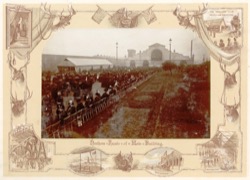
[border]border, four sides, with figures
QUEEN VICTORIA 1837.
E PLURIBUS UNUM
THE "WELCOME" CLUB AMERICAN EXHIBITION.
"WHEELOCK" ENGINE
NEW YORK HARBOUR
MAIN ENTRANCE
MAIN BUILDING
Northern Façade of Main Building.
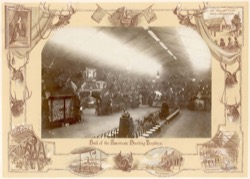
[border]border, four sides, with figures
QUEEN VICTORIA 1837.
E PLURIBUS UNUM
THE "WELCOME" CLUB AMERICAN EXHIBITION.
"WHEELOCK" ENGINE
NEW YORK HARBOUR
MAIN ENTRANCE
MAIN BUILDING
Hall of the American Hunting Trophies.

[border]border, four sides, with figures
QUEEN VICTORIA 1837.
E PLURIBUS UNUM
THE "WELCOME" CLUB AMERICAN EXHIBITION.
"WHEELOCK" ENGINE
NEW YORK HARBOUR
MAIN ENTRANCE
MAIN BUILDING
Hall of the American Hunting Trophies.
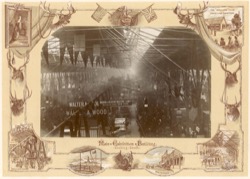
[border]border, four sides, with figures
QUEEN VICTORIA 1837.
E PLURIBUS UNUM
THE "WELCOME" CLUB AMERICAN EXHIBITION.
"WHEELOCK" ENGINE
NEW YORK HARBOUR
MAIN ENTRANCE
MAIN BUILDING
Main Exhibition Building.
(Looking South.)
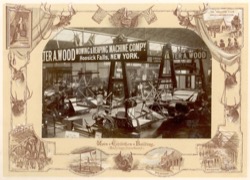
[border]border, four sides, with figures
QUEEN VICTORIA 1837.
E PLURIBUS UNUM
THE "WELCOME" CLUB AMERICAN EXHIBITION.
"WHEELOCK" ENGINE
NEW YORK HARBOUR
MAIN ENTRANCE
MAIN BUILDING
Main Exhibition Building.
(Machinery Department.)
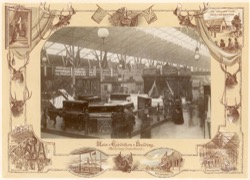
[border]border, four sides, with figures
QUEEN VICTORIA 1837.
E PLURIBUS UNUM
THE "WELCOME" CLUB AMERICAN EXHIBITION.
"WHEELOCK" ENGINE
NEW YORK HARBOUR
MAIN ENTRANCE
MAIN BUILDING
Main Exhibition Building.
(Machinery Department.)
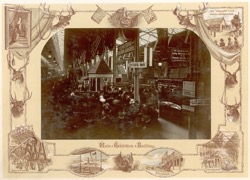
[border]border, four sides, with figures
QUEEN VICTORIA 1837.
E PLURIBUS UNUM
THE "WELCOME" CLUB AMERICAN EXHIBITION.
"WHEELOCK" ENGINE
NEW YORK HARBOUR
MAIN ENTRANCE
MAIN BUILDING
Main Exhibition Building.
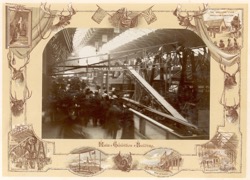
[border]border, four sides, with figures
QUEEN VICTORIA 1837.
E PLURIBUS UNUM
THE "WELCOME" CLUB AMERICAN EXHIBITION.
"WHEELOCK" ENGINE
NEW YORK HARBOUR
MAIN ENTRANCE
MAIN BUILDING
Main Exhibition Building.
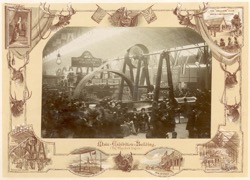
[border]border, four sides, with figures
QUEEN VICTORIA 1837.
E PLURIBUS UNUM
THE "WELCOME" CLUB AMERICAN EXHIBITION.
"WHEELOCK" ENGINE
NEW YORK HARBOUR
MAIN ENTRANCE
MAIN BUILDING
Main Exhibition Building.
(The Wheelock Engine)
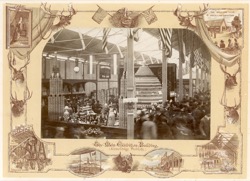
[border]border, four sides, with figures
QUEEN VICTORIA 1837.
E PLURIBUS UNUM
THE "WELCOME" CLUB AMERICAN EXHIBITION.
"WHEELOCK" ENGINE
NEW YORK HARBOUR
MAIN ENTRANCE
MAIN BUILDING
The Main Exhibition Building.
(Alimentary Products)

[border]border, four sides, with figures
QUEEN VICTORIA 1837.
E PLURIBUS UNUM
THE "WELCOME" CLUB AMERICAN EXHIBITION.
"WHEELOCK" ENGINE
NEW YORK HARBOUR
MAIN ENTRANCE
MAIN BUILDING
Band Stand in Western Garden.
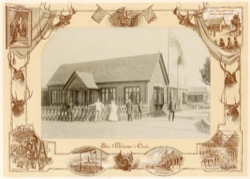
[border]border, four sides, with figures
QUEEN VICTORIA 1837.
E PLURIBUS UNUM
THE "WELCOME" CLUB AMERICAN EXHIBITION.
"WHEELOCK" ENGINE
NEW YORK HARBOUR
MAIN ENTRANCE
MAIN BUILDING
The "Welcome" Club.
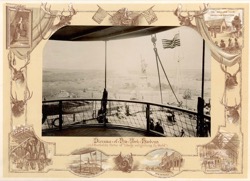
[border]border, four sides, with figures
QUEEN VICTORIA 1837.
E PLURIBUS UNUM
THE "WELCOME" CLUB AMERICAN EXHIBITION.
"WHEELOCK" ENGINE
NEW YORK HARBOUR
MAIN ENTRANCE
MAIN BUILDING
Diorama of New York Harbour.
(and Bartholdi's Statue of "Liberty enlightening the World.")
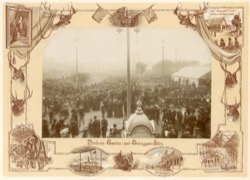
[border]border, four sides, with figures
QUEEN VICTORIA 1837.
E PLURIBUS UNUM
THE "WELCOME" CLUB AMERICAN EXHIBITION.
"WHEELOCK" ENGINE
NEW YORK HARBOUR
MAIN ENTRANCE
MAIN BUILDING
Northern Garden and Toboggan Slide.
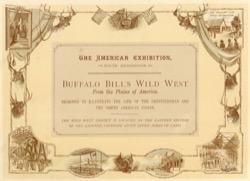
[border]border, four sides, with figures
QUEEN VICTORIA 1837.
E PLURIBUS UNUM
THE "WELCOME" CLUB AMERICAN EXHIBITION.
"WHEELOCK" ENGINE
NEW YORK HARBOUR
MAIN ENTRANCE
MAIN BUILDING
THE AMERICAN EXHIBITION,
SOUTH KENSINGTON.
BUFFALO BILL'S WILD WEST
From the Plains of America.
DESIGNED TO ILLUSTRATE THE LIFE OF THE FRONTIERSMAN AND
THE NORTH AMERICAN INDIAN.
THE WILD WEST EXHIBIT IS LOCATED ON THE EASTERN SECTION
OF THE GROUNDS, COVERING ABOUT SEVEN ACRES OF LAND.
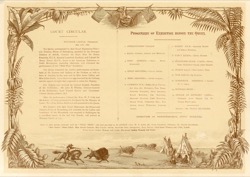
[border]
E PLURIBUS UNUM
COURT CIRCULAR.
WINDSOR CASTLE, THURSDAY,
May 12th, 1887.
The Queen, accompanied by their Royal Highnesses Prince and Princess Henry of Battenberg, attended by the Dowager Duchess of Athole, General the Right Hon. Sir Henry Ponsonby, K.C.B., General Lynedoch Gardiner, and Colonel Sir Henry Ewart, K.C.B., drove to the American Exhibition in South Kensington, yesterday afternoon, and witnessed the performances of the "Wild West" Exhibition.
The Queen witnessed the various performances on horseback of the Hunters and Indians of the Prairies, as well as feats of shooting by the men and by Miss Annie Oakley and Miss Lilian Smith. A war dance was also executed by the Indians, and the squaws brought their papooses to salute her Majesty.
Her Majesty was received by Colonel Russell, President of the Exhibition; Mr. John R. Whitley, Director-General of the Exhibition; Lord Ronald Gower, and Lieutenant-Colonel Hughes-Hallett, M.P.
After the performance, Colonel the Hon. W. F. Cody had the honour of being presented to the Queen by the Marquis of Lorne. Two of the Indian chiefs were also presented to the Queen.
Her Majesty, with their Royal Highnesses the Prince and Princess Henry of Battenberg, and attended by the Ladies and Gentlemen of the Household, was escorted to Paddington by a travelling escort of the 2nd Life Guards, and arrived at Windsor Castle at 7:30.
PROGRAMME OF EXHIBITION BEFORE THE QUEEN.
- 1. INTRODUCTORY PARADE.
- 2. RACE.—COWBOY, INDIAN AND MEXICAN.
- 3. PONY EXPRESS.—Rider, MARK BEARDSLEY
- 4. RIFLE SHOOTING.—LILIAN SMITH.
- 5. WING SHOOTING.—ANNIE OAKLEY.
- 6. COWBOY'S FUN.—Riders, BUCK TAYLOR, JIM KID, JIM MITCHELL, TOM WEBB, ANTONIO ESQUIVEL, DICK JOHNSON, BILLIE BULLOCK, JOE ESQUIVEL, BRONCHO CHARLIE, JOHN HANCOCK, BILLIE PUGH, CHEROKEE BILL, TOM DUFFY, FRANK WHEELING, JOHNNIE BAKER.
- 7. LADIES' RACE.—GEORGIE DUFFY and DELLA FERRELL.
- 8. FANCY RIDING.—EMMA HICKOK.
- 9. DEADWOOD STAGE COACH.—Driver, FRED MATHEWS—Guard, JOHN NELSON.
- 10. INDIAN RACE.—TWO INDIAN BOYS.
- 11. WAR DANCE.—85 INDIANS.
- 12. HORSEBACK SHOOTING.—Colonel W. F. CODY.
- 13. BUFFALO HUNT.—
- 14. ATTACK ON SETTLERS' CABIN.—Principals, JOHN NELSON and Mr. FRANK WHITTAKER.
- ORATOR.—Mr. FRANK RICHMOND.
- DURATION OF PERFORMANCE, FIFTY MINUTES.
Names of those persons connected with the "WILD WEST" who were presented to the QUEEN—COL. W. F. CODY, Mr. NATE SALSBURY (Director), Mr. FRANK RICHMOND, "RED SHIRT" (Sioux Chief), Miss ANNIE OAKLEY, Miss LILIAN SMITH, BRONCHO BILL (Interpreter), ELLA IRVING (Half-breed Woman) and Child, LIZZIE, UNPA-TO-HA (Indian Woman) and Child, HA-PE-AH (Indian Woman) and Child.
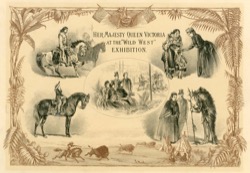
[border]
E PLURIBUS UNUM
HER MAJESTY QUEEN VICTORIA AT THE "WILD WEST" EXHIBITION.
[drawing] [drawing] [drawing] [drawing] [drawing]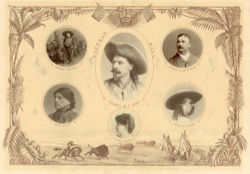
[border]
E PLURIBUS UNUM
BENNIE IRVING
[photo]RED SHIRT
[photo]"BUFFALO BILL"
COLONEL W. F. CODY
[photo]MRS. NATE SALSBURY
[photo]ALBERT E. SCHEIBLE
[photo]JOHN M. BURKE

[border]
E PLURIBUS UNUM
BUFFALO BILL'S "WILD WEST"
[photo]LILIAN SMITH.
[photo]BUCK TAYLOR.
[photo]SERGT BATES.
[photo]ANNIE OAKLEY.

[border]
E PLURIBUS UNUM
BUFFALO BILL'S "WILD WEST"
[image]MOUNTING A BUCKING HORSE.
[image]THE DEADWOOD STAGE COACH.
[image]RIDING A BUCKING HORSE.

[border]
E PLURIBUS UNUM
HUNTING WILD BUFFALOES.
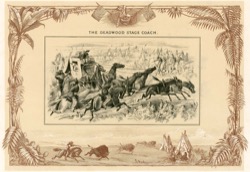
[border]
E PLURIBUS UNUM
THE DEADWOOD STAGE COACH.
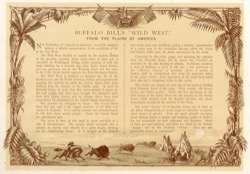
[border]
E PLURIBUS UNUM
BUFFALO BILL'S "WILD WEST,"
FROM THE PLAINS OF AMERICA.
NO Exhibition of "America in miniature" would be complete without a faithful representation of the conditions of life in the Far West.
The Wild West Exhibit is located on the eastern section of the grounds, covering about seven acres of land, and is accessible by Washington Bridge, which connects it with the main building, by a covered way from Earl's Court Station, and two gateways, one in the Warwick Road and the other in the Lillie Road directly opposite the West Brompton Station.
The Wild West is designed to illustrate the life of the frontiers-man and the North American Indian, and to graphically pourtray the methods by which the United States have been civilised, from the Atlantic to the Pacific coast. It must be distinctly borne in mind that this representation is given by the real people, who have been brought five thousand miles from their prairie homes, and by Indians taken from their reservations by permission of the United States Government.
The grounds are triangular in shape. The Grand Stand faces the east, and is the largest structure of the kind ever erected in England. It is entirely covered and crescent-shaped. It will hold about 20,000 people. Under the Grand Stand are refreshment bars.
The arena in front of this stand is about one-third of a mile in circumference. The scenery which surrounds this is painted on canvas and extends to a great height, shutting out the neighbouring houses. It is merged at the bottom into rocks, trees, and shrubbery, giving a realistic representation of a rocky pass in the mountains through which the scouts and Indians defile upon the plains represented by the arena.
Concealed by this rocky gorge, and adjoining the entrance from the Warwick Road, will be found the "Corral," an enclosure for the safe keeping of animals. In this are contained a herd of buffaloes, a herd of elk, and a few specimens of the "Washoe Canary," or mountain burro, a species of donkey used in transporting ores from the mountain mines to the plains below. Some specimens of the small black-tailed deer also find a temporary home in this corral.
The stables are ranged on each side of the roadway leading from Warwick Road to the camp. They contain 166 bronco horses and Indian ponies. These are fine specimens of the wild horses of the plains, which are the progeny of the Berber horses which escaped from the Spanish invaders, and whose descendants overspread the prairies of the West.
The word "bronco" is of Spanish origin, and is used on the plains irrespectively to mean rough or unbroken as regards either horses or ground. They are small animals, averaging about thirteen hands in height, and weighing 500lbs. or 600lbs., but are remarkable for their endurance and fleetness. Many of them are parti-coloured, and these are called by the Indians "Cyuse" and by the Cowboys "Pintos." They are also generically known as "mustangs."
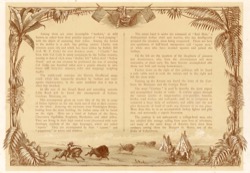
[border]
E PLURIBUS UNUM
Among then are some incorrigible "buckers," or wild horses, so called from their peculiar manner of "buck-jumping" with the object of unseating their riders. Among the horses in the stables is a dark bay gelding named Charlie, now nineteen years old, and which has been ridden by Buffalo Bill (Col. W. F. Cody) for over fourteen years. "Charlie" has been with Col. Cody in many campaigns in the Indian country, notably in that of 1876, when "Buffalo Bill" killed chief "Yellow Hand," and on one occasion he performed the feat of carrying Col. Cody one hundred miles over a prairie country in nine hours and forty-five minutes, rider and trappings weighing 243lbs.
The stable-yard contains the historic Deadwood stage coach, which was repeatedly attacked by Indians and road-agents (highwaymen), in the same condition that it was in when last attacked.
In the rear of the Grand Stand and extending towards Lillie Road will be found the encampment of Indians, Cowboys, Mexicans, etc.
This encampment gives an exact idea of the life in camp of Indian fighters on the one hand, and of that of their enemies on the other. Entering the enclosure from Washington Bridge, leading from the main building, the Indian camp will be found on the right. Here a band of Indians of the Sioux, Cheyennes, Ogallallas, Arapahoes, Shoshones, and other tribes. They are living in their high conical tents (decorated with rude drawings, symbols of the sign language), which are called "tepees," They are accompanied by their "squaws" and "pappooses," or wives and children.
The entire band is under the command of "Red Shirt," a distinguished Indian chief and warrior, who has intelligently accepted the situation, since being conquered. There are here also specimens of half-breed interpreters and "squaw men," or white men who have married squaws and joined the Indians.
On the left are the quarters of the daughters of pioneers and frontiersmen, who, from the circumstances and stern necessities of their early life, have become accomplished rifle shots, and bold and daring horsewomen.
Farther down on the right of this pathway, will be found a rude cabin used to cook the rations, and to the right and left the mess tents.
Turning up the Avenue are found the tents of the Cowboys, the Mexicans, and the Cowboy Band.
The word "Cowboy" is used to describe the most expert and accomplished herder of cattle. A cowboy passes through the various grades of range-worker, cow-puncher, brander, herder, road worker, and trail-guide, until he is competent to command a large body of assistants, and safely care for and pilot thousands of head of cattle any distance or to any place. More than this, he is an accomplished Indian fighter and rifle shot, and necessarily a superb horseman.
The cowboy is not unfrequently a college-bred man, who has adopted this strange calling from pure love of adventure, and many of the cattle kings of America have risen from cowboys, among them the Marquis de Mores, son of the Duke of Vallambrosa.
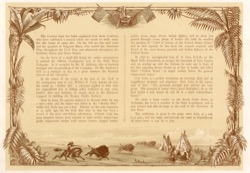
[border]
E PLURIBUS UNUM
The Cowboy band has been organised from those Cowboys who have cultivated a natural talent for music to while away the idle hours of camp life. On the left are the staff tents and the quarters of Sergeant Bates, who carried the American Flag throughout the Civil War, and afterwards throughout the Southern States and Great Britain.
On the brow of a small hill facing the entire encampment is pitched the Official Headquarter tent of the Wild West Company. It is occupied by Mr. N. Salsbury, who is business manager and vice-president of the Company. To Mr. Salsbury's skill as a manager is due, in a great measure, the financial success of the enterprise.
In the centre of the camp, at the foot of the bluff, is the headquarter tent of Col. William F. Cody, known all over the world as "Buffalo Bill," a sobriquet applied to him after his unparalleled feat of killing 4,862 buffaloes in one year, besides deer and antelope, to supply meat to the labourers engaged in building the Kansas Pacific Railway.
Born in Iowa, his parents removed to Kansas while he was a mere child, and his father was killed in the "Border War" whilst Col. Cody was yet a boy. Thrown on his own resources at an early age, his life from that time to this has been a record of the most marvellous adventures. Colonel Cody has been despatch bearer, pony express or mail carrier, wagon-train guide, wagon-train master, train master, hunter, trapper, trailer, guide, scout, stage driver, Indian fighter, and in short has passed through every phase of border life until he reached the position of "Chief of Scouts of the United States Army," and in that capacity he has been the trusted comrade and friend of the most famous generals and Indian fighters of the United States.
In 1876 he accompanied Gen. E. A. Carr, U.S.A., on the Black Hills Expedition, to avenge the massacre of Gen. Custer, and, on coming up with the Indians, he rode out in front of the two opposing forces, drawn up in line of battle, and killed Chief "Yellow Hand" in single combat before the general engagement began.
Col. Cody is a perfect horseman, an unerring shot, and of magnificent presence and physique. Gen. Carr, in his report, says of him: "His personal strength and activity are very great. His eyesight is better than a good field-glass; he is the best trailer I ever heard of, and he is a most extraordinary hunter."
He owns a large ranche on the North Platte River, in Nebraska, has been a member of the State Legislature, and is now colonel and aide-de-camp on the staff of the Governor of that State.
The exhibition is given in the arena twice daily, at 3 and 8.30 p.m., and the camp and grounds are open to inspection at all times from 11 a.m. to 11 p.m.
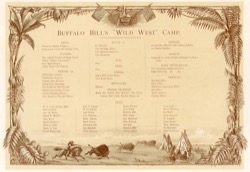
[border]
E PLURIBUS UNUM
BUFFALO BILL'S "WILD WEST" CAMP.
- Seventeen Indian Teepees.
- Forty-seven Camp and Dining Tents.
TENTS.
- The original Deadwood Stage Coach.
- Three "Prairie Schooners."
- One Band Wagon.
- Three Dead Axle Wagons.
WAGONS.
- Thirty-three Oregon.
- Twenty-one Kigyuse.
- Twenty-eight Broncos.
- Thirty-three Mustangs.
- Ten California Half-breeds.
- Twenty-nine Indian Ponies.
- Twenty Bucking Horses.
- Two American Draught Horses.
HORSES, 176.
- Six Missouri.
- Two Bucking Mules.
- Two Spanish-American.
- Two Kentucky.
MULES, 12.
- Nine.
ELK.
- Two.
DEER.
- Eight Wild Texas Steers.
- Two Work Oxen.
STEERS.
- Sixteen.
BUFFALOES.
- Bows and Arrows, War Bonnets, War Shirts, Lances, War Clubs, Shields, Scalps, &c.
INDIAN TROPHIES.
- 200 genuine Mexican and Cowboy Saddles.
- 100 Indian Saddles.
SADDLES.
- Captured in various Indian campaigns by Scout Cody.
EFFECTS
- Two Zacatecas, Buffalo-mounted.
- Eight American, do. do.
BAND INSTRUMENTS.
- Sporting Rifles.
- Shot Guns.
- Winchester Repeating Rifles.
- Revolvers.
- Bowie Knives.
- Cavalry Sabres.
ARMOURY.
| W. F. Cody (Buffalo Bill). | Wm. C. Gayler. | Frank Whelan. | Tom Duffy. |
| Nate Salsbury. | W. O. Snyder. | Tom Webb. | Maror Beardsly. |
| Jno. M. Burke. | Lew Parker. | Broncho Bill. | Kit Buell. |
| Albert E. Sheible. | J. S. Cannon. | Billy Pugh. | Tony Esquivel. |
| Jules Keen. | Robt. Morris. | Jno. Hancock. | W. Langon. |
| Carter Couturier. | Buck Taylor. | Billy Bullock. | Chas. Smith. |
| Thos. J. Cash. | Cherokee Bill. | Jim Kid. | Thos. Mahoney. |
| Harry A. Lee. | Jim Mitchell. | Broncho Bill. | H. Hunstine. |
| Frank Richmond. | Dick Johnson. | Johnny Baker. | Dave Lawrence. |

[border]
E PLURIBUS UNUM
| Robt. Taylor. | D. F. Esquivel. | Jno. Boyer. | Fred. Lavigne. |
| Joe Artman. | José Romay. | J. Ferguson. | J. K. Whaley. |
| Cal. Mullen. | Serapio Rivera. | Jno. Nelson. | James Brown. |
| Chas Bumback. | Ben Galindo. | Frank White. | Jno. Dunn. |
| Dave Wilson. | Andreas. | A. Jalbert. | Wm. Hunt. |
| Henry Lounge. | Pedro Esquivel. | E. Lehfelt. | Jno. Hayday. |
| Louis Hatch. | Emilio Guiterrez. | J. Small. | Arn. Robinson. |
| Wm. Lansfield. | Carlo Martinez. | E. Y. Snyder. | Knocker Ring. |
| Wm. M'Cune. | Sancho Hernandez. | G. W. Turner. | Tom Cupping. |
| Court Mason. | Don Henriques. | C. J. Johnson. | John Jones. |
| Frank Wilson. | Antonio Pubero. | D. J. Merrill. | James Bass. |
| C. A. Bailey. | Dovaro Finellio. | Frank Smart. | J. W. Herbert. |
| Chas. Davis. | Ed. King. | C. P. Illman. | Geo. White. |
| John Oakes. | Arthur King. | Miss Emma Hickock. | Jas. Quinn. |
| A. Marchand. | Mustang Jack. | " Della Ferrell. | Jas. Cutter. |
| Wm Sweeny. | Capt. Fred. Matthews. | " Poncha Aguero. | Jno. Gaines. |
| Chas. Sturm. | Henry Melmer. | " Annie Oakley. | Swift Jackson. |
| W. H. Cox. | Tom Williams. | " Lilian Smith. | Henry Martin. |
| D. W. Shoemaker. | Sergt. Bates. | " Georgie Duffy. | Andrew Wood. |
| Chris Schetting. | Fred. Bowman. | " Bessie Ferrel. | Samuel Arthur. |
| H. Kniep. | Barney Comrie. | " Fannie Woodward. | Wm H. Harrison. |
| Jno. Link. | Eddie Goodman. | " Lizzie Stanton. | Frank P. Nicoll. |
| Andrew Link. | Bob Williams. | Mrs. Margaret Whitaker. | James Kitchen. |
| Thos. Murphy. | S. Canfield. | " Annie Ferrell. | Edward M'Pherson. |
| S. K. Thomes. | C. D. Maxwell. | " A. Esquivel. | Oliver Stevens. |
| Leon Joret. | Burt Fuller. | Antonio Provost. | Morris Kerns. |
| Juan Bille. | Jesse Hinds. | John Higby. | Jas. Mulroy. |
| Timeteo Caber. | Eugene Overton. |
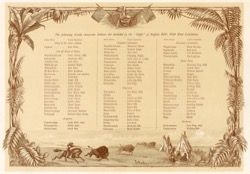
[border]
E PLURIBUS UNUM
The following North American Indians are included in the "Outfit" of Buffalo Bill's Wild West Exhibition.
| Indian Names | English Equivalent. |
| Ogila-sa | Red Shirt. |
| Wan-Kan-Ki-yan | Flies Above, chief. |
| Pahawanka | Medicine Hill. |
| Tata-Ka-wi-sa | Bull Man. |
| Wable-gle-gra | Spotted Eagle. |
| Wahorpileta | Red Nest. |
| Wi-Keu-Ke-to | Blue Rainbow. |
| Ki-ci-e-cun | Wounds one another. |
| Too-ti | Wounded. |
| Haraka-Wable | Eagle Elk. |
| Wable-canto | Eagle Heart. |
| Wahan-pa-mani | Arrow Wound. |
| Cet-an-ogoiko | Swift Hawk. |
| Tanka-sha-hinka | Slow White Bull. |
| Sunka-ska | White Horse. |
| Sunka-wanaga | Dog's Ghost |
| Iyan-mato | Rocky Bear. |
| Mato-yanni | Three Bears. |
| Zenkaelo-ska | White Bird. |
| Chiyrolo-wapato | Cheyenne Butcher. |
| Teweya-gli | Returns from Scout. |
| Tata-ka-ahaga | Little Bull, chief. |
| Wica-rapi-sha | White Star. |
| Okislia-waste | Good Boy. |
| Indian Names. | English Equivalent. |
| Sasunka-wakanlo | Medicine Horse. |
| Wable-glasha | Spotted Eagle. |
| Hihan-luta | Red Owl. |
| Wabli-watapho | Charging Eagle. |
| Taeayla-wicoklo | Kills close to Lodge. |
| Wasien-mato | American Bear. |
| Calan-luto | Red Hawk. |
| Wusta-Rago | Makes Good. |
| Mato-iyanko | Running Bear. |
| Icna-Kinze | Fights all Alone. |
| Tusnhu-warahm | Broken Thigh. |
| Wicasa-takla | Little Big Man. |
| Sunka-luta | Red Dog. |
| Tolo-kokco | Cut Meat, chief. |
| Okisilo | Boy. |
| Pa-ranreyl | Stands on Hill. |
| Tawska-kinzi | Yellow Horse. |
| Harka-placolo | Short Elk. |
| Harka-sapa | Black Elk. |
| Maya-hanka | Piece of Iron. |
| Jeaga | Raised. |
| Tosunka-cicila | Little Horse. |
| Jangla-hayenha | Runs Close. |
| Se-oka | Cut Foot. |
| Haraka-wakan | Medicine Elk. |
| Cara-sapa | Black Kettle. |
| Indian Names. | English Equivalent. |
| Wapaha-sapa | Black Bonnet. |
| Oguha-luta | Red Sack. |
| Paguta-hanska | Tall Medicine. |
| Tohuska-tanka | Big Leggings. |
| Hanpisk-ka | Mocassin Top, chief. |
| Pamin-gila | Yellow Hair. |
| A-caupe | Hollows Behind. |
| Roka | Badger. |
| Mato-wan-kantya | High Bear. |
| Wable-wan-Kanbye | High Eagle. |
| Hape-yape | Throws away. |
| Mato-orouko | Rushing Bear. |
| Maka | Ground. |
| Woelna-gi | Stands up. |
| Wamble-nupa | Two Eagles. |
| Tieu-gla-kati | Kills close to Hill. |
| Okisila | Bissonett. |
| Natinsane-mage | Standing Rabbit. |
| Harake-bloka | Doe Elk. |
| Wiciyala | Yankton. |
| Si-tunka | Big Foot. |
| Nape | Hand. |
| Sunka-tamaca | Poor Dog, chief. |
| Tataka-mona | Walking Bull. |
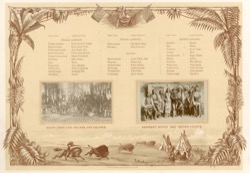
[border]
E PLURIBUS UNUM
| Indian Names. | English Equivalent. |
| Ticagla-inyanka | Runs close to Lodge. |
| Maga-howaste | Iron Good Voice. |
| Wable-nupa-oksila | Two Eagle Boy. |
| Sunka-Owiesiha | Gives away Horses. |
| Wanni-Yonin-sicola | Little Whirlwind. |
| Ota-Kate | Kills Plenty. |
| Cipe | Black. |
| Sinna-rilisa | Torn Blanket. |
| Wakiya-ska | White Lightning. |
| Harake-magi | Standing Elk. |
| Mawakan | Sword. |
| Indian Names. | English Equivalent. |
| Mats-wasagse | Old Black Bear. |
| Sila-Ktae | Kills Pawnees. |
| Macaci-Kaola | Little Chief, chief. |
| Hupe-ka | Picket Pin. |
| Tasinka-hinsa | Sorrel Horse. |
| Moto-nagi | Standing Bear. |
| To-kikya-kte | Kills First. |
| Cante-sapa | Black Heart. |
| Indian Names. | English Equivalent. |
| Itunhala | Mouse. |
| Sha | White. |
| Watan-ya | Good Light. |
| Asampi | Milk. |
| Tanuka-wable | Eagle Horse. |
| Shitoni | Spider. |
| Sunkinto | Blue Horse. |
| Wohn-wiza | Two Lance. |
| Tospi-cici-ja | Little Wound. |
| Sina-san | Grey Blanket. |
| Catuhe tanka | Big Ribs. |
NORTH AMERICAN INDIANS AND SQUAWS.
[photo]SERGEANT BATES AND INDIAN CHIEFS.
WATERLOW & SONS LIMITED, LONDON WALL, LONDON
Note: May have been printed by the company Waterlow & Sons Limited, London Wall, London, England. Front cover verso inscription is by Alfred C. Irving: From https://www.lib.rochester.edu/index.cfm?PAGE=3092 "A keen admirer of Buffalo Bill, A. C. Irving of Milton, Massachusetts, sought permission to remove the three Cody children buried in Mount Hope and re-inter them with their parents. New York State law, however, required permission of two surviving grandsons, which was not obtained. Mount Hope, therefore, retains the idealized dreams of a father and is one of the few places of permanence in the life of a legendary, peripatetic showman."
Title: Souvenir Album of the visit of Her Majesty Queen Victoria to the American Exhibition
Source: James Wojtowicz Collection, McCracken Research Library, Buffalo Bill Center of the West, MS327
Date: 1887
Topics: Buffalo Bill's Wild West in Britain
People: Applin, Vincent Augustin Ferrel, Della Little Chief, b. 1851 Richmond, Frank, -1890 Robinson, Emma Lake Thatcher Russell, Henry Sturgis Whitley, John Robinson, 1843-1922
Sponsor: This project is supported in part by a grant from the National Endowment for the Humanities and the Geraldine W. & Robert J. Dellenback Foundation.
Editorial Statement | Conditions of Use
TEI encoded XML: View wfc.mem00276.xml
Back to top
